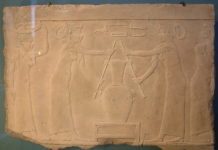
With a rock-and-rope anchor, prehistoric boats such as hollowed-out tree trunks or round, bowl-shaped coracles could be held in place by sheer weight. Either that, or they could be kept secure by the friction set up when primitive anchors dragged along the bed of a lake or river.
Anchors for Ships in the Open Sea
The same effect could be achieved by variations on the basic idea – a basket full of stones, a sack of sand, a bag full of shingle or a chunk of wood weighted with lead. Methods like these served well enough so long as ships were neither too large nor too heavy or when voyages were made in relatively sheltered waters.
Something more reliable and sturdy was, however, needed when humans began to venture out into the open sea or along exposed coastlines in larger ships.
One simple and effective idea developed quite early on in ancient Malaysia – a contoured anchor with a single fluke. This was made from two wooden sticks, the short stick, the fluke, sharpened to a point, and tied at an angle to the long stick, the shank.
Anchors Used by the Romans
A great deal later, Roman anchors, also made of wood but with two flukes, were found in 1932 when two large vessels were brought to the surface after spending nearly eighteen centuries beneath the waters of Lake Nemi, near Rome.
The wood the Romans used were no mere sticks, though. They comprised thick, strong blocks and the anchors had flukes that were sharpened and tipped with metal. The stock was made of lead.
The Vikings Venture out to Sea
Many centuries later, the Vikings from Scandinavia were careful to secure their ships in the violent weather prevalent around the coasts of northern Europe. The sleek, fast vessels in which they sailed to terrorize villages, monasteries and towns along the east coast of Britain and the northern coasts of Germany and the Netherlands carried large anchors with several feet of iron chain.
The anchor of the 9th century Viking ship discovered at Gokstad in Norway in 1880 had a stock just under nine feet long, a massive size designed to give it maximum stability when hooked into the sea bed. The anchor itself was never found, but the evidence gleaned from other Viking finds suggests that its two arms curved upwards, into the familiar anchor shape.
Straight-Armed and Stockless Anchors
Not all anchors were shaped in that fashion, though, The straight-armed anchor, for example, remained common until the early years of the 19th century. The age in which the curved arms were restored, in 1813, was also the age of fascination with machinery and an eagerness to experiment, invent and innovate. It was that venturesome climate that produced the first important advance to take place in design since anchors first acquired their flukes – the stockless anchor patented in 1821.
Stockless anchors have arms in one plane and are pivoted to the shank, enabling the shank to swing from side to side without breaking the anchor’s hold. There are also easy to release quickly.
A Range of Anchors for a Range of Conditions
As well as developing a variety of shapes, some anchors have also changed their original task of keeping a ship firmly moored. Anchors today are versatile ancillaries to life at sea and apart form the bower used for general anchoring purposes, ships carry a range of anchors to deal with special conditions.
One is the floating sea anchor, most often made of canvas and spars, which acts as a kind of nautical parachute. It enables ships to ride out heavy seas more safely than would otherwise be the case, helps reduce leeway and keeps a ship’s bows headed into the sea and wind. A small craft in danger of veering sideways onto wind and waves, or broaching, uses its own type of sea anchor, the drogue.
The stream anchor, which is about one quarter the weight of the usual bower anchor, prevents a ship from swinging while anchored. The small kedge anchor is used in a ship in much the same way as the grappling hook is by a mountain climber scaling a near-vertical surface. The kedge attached to a line is taken out for a distance in a small boat and dropped to the bottom after which the ship is hauled up to it.
Unlike an Anchor, but an Anchor just the Same
There are also anchors that look nothing like anchors, either ancient or modern. One, the stockless grapnel, has four or five curved claws and is most commonly used for securing skiffs, dories and other small boats.
Another, the mushroom anchor, used for mooring vessels such as lightships, lighters and dredges, has the virtue of being able to burrow deep into the seabed and hold fast through the suction that follows naturally from its shape.
Sources
- Curryer, Betty Nelson: Anchors: The Illustrated History (Annapolis, Maryland: US Naval Institute Press, 1999) ISBN-10: 155750041X/ISBN-13: 978-1557500410
- Upham, N.E. Anchors. (Botley, Oxford, UK: Shire Books, 2008, ISBN-10: 0747805083/ISBN-13: 978-0747805083







